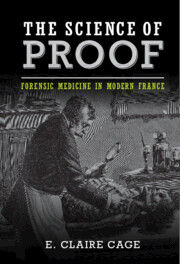46 results
Analysis and evaluation of peer group support for doctors in postgraduate training following workplace violence and aggression
-
- Journal:
- BJPsych Bulletin , FirstView
- Published online by Cambridge University Press:
- 16 May 2024, pp. 1-8
-
- Article
-
- You have access
- Open access
- HTML
- Export citation
The Doctor in Free Movement Law: Expertise, Duty, and Accountability
-
- Journal:
- Cambridge Yearbook of European Legal Studies , First View
- Published online by Cambridge University Press:
- 21 December 2023, pp. 1-27
-
- Article
-
- You have access
- Open access
- HTML
- Export citation
14 - The Medical Revolution in Early Modern Japan
- from Part III - Social Practices and Cultures of Early Modern Japan
-
-
- Book:
- The New Cambridge History of Japan
- Published online:
- 15 January 2024
- Print publication:
- 23 November 2023, pp 478-506
-
- Chapter
- Export citation
11 - Sustaining Life and Healing Bodies
-
- Book:
- Middle Imperial China, 900–1350
- Published online:
- 20 July 2023
- Print publication:
- 03 August 2023, pp 269-293
-
- Chapter
- Export citation
3 - ‘A Bitter Blow’
-
- Book:
- The Battle to Control Female Fertility in Modern Ireland
- Published online:
- 11 May 2023
- Print publication:
- 25 May 2023, pp 81-122
-
- Chapter
- Export citation
Conclusion
-
- Book:
- The Battle to Control Female Fertility in Modern Ireland
- Published online:
- 11 May 2023
- Print publication:
- 25 May 2023, pp 302-313
-
- Chapter
- Export citation
5 - ‘Against Sin’
-
- Book:
- The Battle to Control Female Fertility in Modern Ireland
- Published online:
- 11 May 2023
- Print publication:
- 25 May 2023, pp 161-196
-
- Chapter
- Export citation
4 - The Physical, Mental, and Social Effects of Hunger
-
- Book:
- The Atrocity of Hunger
- Published online:
- 09 February 2023
- Print publication:
- 16 February 2023, pp 77-90
-
- Chapter
-
- You have access
- Open access
- HTML
- Export citation
Physicians imprisoned in Franco Spain’s Miranda de Ebro “Campo de Concentración”
-
- Journal:
- Medical History / Volume 66 / Issue 3 / July 2022
- Published online by Cambridge University Press:
- 17 January 2023, pp. 264-279
-
- Article
-
- You have access
- HTML
- Export citation
Labour migration of doctors and nurses and the impact on the quality of health care in Eastern European countries: The case of Poland
-
- Journal:
- The Economic and Labour Relations Review / Volume 30 / Issue 2 / June 2019
- Published online by Cambridge University Press:
- 01 January 2023, pp. 307-320
-
- Article
- Export citation
Misusing our talent? Overeducation, overskilling and skill underutilisation among Spanish PhD graduates
-
- Journal:
- The Economic and Labour Relations Review / Volume 27 / Issue 4 / December 2016
- Published online by Cambridge University Press:
- 01 January 2023, pp. 432-452
-
- Article
- Export citation
Chapter 3 - Dissection in the Roman Period
- from Part I - Practice
-
- Book:
- Dissection in Classical Antiquity
- Published online:
- 18 November 2022
- Print publication:
- 08 December 2022, pp 54-90
-
- Chapter
- Export citation
2 - The Early Years
-
- Book:
- The Abortion Act 1967
- Published online:
- 03 November 2022
- Print publication:
- 17 November 2022, pp 28-65
-
- Chapter
- Export citation
1 - The Science of Death
-
- Book:
- The Science of Proof
- Published online:
- 25 August 2022
- Print publication:
- 01 September 2022, pp 12-44
-
- Chapter
- Export citation
Suicide in the medical community
-
- Journal:
- European Psychiatry / Volume 65 / Issue S1 / June 2022
- Published online by Cambridge University Press:
- 01 September 2022, p. S843
-
- Article
-
- You have access
- Open access
- Export citation
3 - Deception and Detection
-
- Book:
- The Science of Proof
- Published online:
- 25 August 2022
- Print publication:
- 01 September 2022, pp 79-109
-
- Chapter
- Export citation

The Science of Proof
- Forensic Medicine in Modern France
-
- Published online:
- 25 August 2022
- Print publication:
- 01 September 2022
Mental health and conspirasism in health care professionals during the spring 2020 COVID-19 lockdown in Greece
-
- Journal:
- Acta Neuropsychiatrica / Volume 34 / Issue 3 / June 2022
- Published online by Cambridge University Press:
- 10 December 2021, pp. 132-147
-
- Article
- Export citation
6 - Hospitals, Doctors and Nurses
-
- Book:
- Comparative Health Systems
- Published online:
- 20 August 2021
- Print publication:
- 09 September 2021, pp 145-178
-
- Chapter
- Export citation
MARTIAL AND THE DOCTORS: OPHTHALMOLOGY AND UVULECTOMY IN EPIGRAM 10.56
-
- Journal:
- The Classical Quarterly / Volume 71 / Issue 2 / December 2021
- Published online by Cambridge University Press:
- 07 September 2021, pp. 907-910
- Print publication:
- December 2021
-
- Article
-
- You have access
- Open access
- HTML
- Export citation



